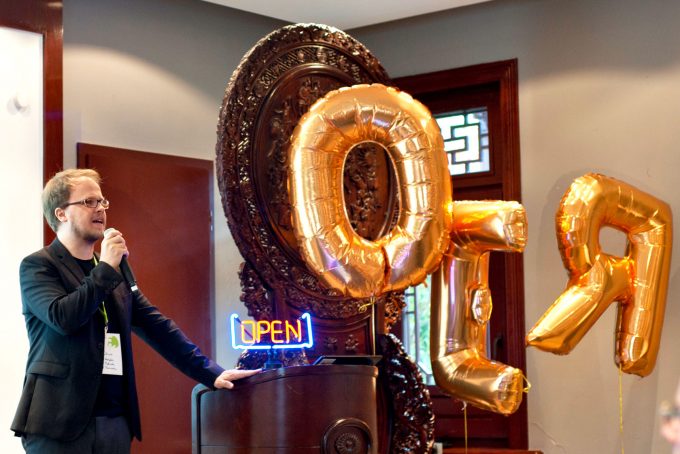
Research & Innovation – Shaping our Future: a Conference Report
On Monday, the 3rd of July, over 700 scientists, innovators, business people and policy makers discussed the future of research and innovation in Europe at the conference Research & Innovation – Shaping our Future, hosted by Carlos Moedas, Commissioner for Research, Science, and Innovation.
The leitmotif of the conference “Research & Innovation – Shaping our Future” was the report presented by the High Level Group (HLG) on maximising the impact of EU Research & Innovation Programmes chaired by Pascal Lamy entitled “LAB – FAB – APP Investing in the European future we want”.
Skip to PDF contentThis report is based on the results of the interim evaluation of Horizon 2020. The HLG formulated eleven recommendations to try maximising the impact of future EU R&I programmes and further increase their return on investment for Europe and Europeans.
LAB – FAB – APP
To raise attention for the issues of research and innovation and to bridge the gap between science and society the HLG used the, in the beginning, puzzling title “LAB – FAB – APP”. Standing for research (“Labs”), innovation-competitive fabrication (“Fabs”) and applications for the benefit of all (“Apps”). Whereas the benefit for all is once again emphasised in the subtitle “Investing in the European future we want”.
In a short and compact publication of only 35 pages, the HLG presents the following eleven recommendations. A key action exemplifies each of them.
We should focus more on the innovators than the innovation
New report w/ 11 recommendations for research & innovation #EUInnovation @moedas pic.twitter.com/HRfPODlp2Q— EUScience&Innovation (@EUScienceInnov) 5. Juli 2017
- Prioritise research and innovation in EU and national budgets. Action: Double the budget of the post-2020 EU research and innovation programme.
- Build a true EU innovation policy that creates future markets. Action: Foster ecosystems for researchers, innovators, industries and governments; promote and invest in innovative ideas with rapid scale-up potential through a European Innovation Council.
- Educate for the future and invest in people who will make the change. Action: Modernise, reward and resource the education and training of people for a creative and innovative Europe.
- Design the EU R&I programme for greater impact. Action: Make the future programme’s pillars driven by purpose and impact, fine-tune the proposal evaluation system and increase flexibility.
- Adopt a mission-oriented, impact-focused approach to address global challenges. Action: Set research and innovation missions that address global challenges and mobilise researchers, innovators and other stakeholders to realise them.
- Rationalise the EU funding landscape and achieve synergy with structural funds. Action: Cut the number of R&I funding schemes and instruments, make those remaining reinforce each other and make synergy with other programmes work.
- Simplify further. Action: Become the most attractive R&I funder in the world, privileging impact over process.
- Mobilise and involve citizens. Action: Stimulate co-design and co-creation through citizen involvement.
- Better align EU and national R&I investment. Action: Ensure EU and national alignment where it adds value to the EU’s R&I ambitions and missions.
- Make international R&I cooperation a trademark of EU research and innovation. Action: Open up the R&I programme to association by the best and participation by all, based on reciprocal co-funding or access to co-funding in the partner country.
- Capture and better communicate impact. Action: Brand EU research and innovation and ensure wide communication of its results and impacts.
Open Science on the agenda for FP 9
While the main focus of the conference and thereby of many sessions was on innovation, the topic Open Science pierced many statements. Commissioner Moedas repeated his position that Open Science is fundamental for Europe’s research and innovation, and Kamila Markram, CEO of Frontiers highlighted that Europe is leading in Open Access publications. Especially Open Data was widely seen as a potential booster for research and innovation and a locational advantage of Europe. Jan Gulliksen (Professor, KTH Royal Insitute of Technology and Member of the HLG) stated in his video that Open Access to publications and data in Europe is crucial. Open Access would enable citizens to participate in evidence-based policy he said.
Appreciated by the European Commission – Pondering silence of the Member States
Commissioner Moedas congratulated the HLG having formulated a crisp and to the point paper that will help to frame the ongoing discussions about FP 9. The European Commission was well represented at the conference, including a panel of five Director-Generals of the European Commission reporting about success stories of research and innovation funded by the European funding programmes. However, the Member States were underrepresented at least on stage. With just the Estonian Minister of Education and Research Mailis Reps sharing her thoughts a pondering silence of the Member States was the elephant in the room. Thus it will be of utmost importance for the European Commission to balance its position with the Member States and the wider society to realise such ambitious goals like doubling the budget.
ICYMI: Watch a recording of '#Research & #Innovation shaping our future' Conference online anytime! https://t.co/1H3h0AXKrf #H2020Future pic.twitter.com/owuFafoC9h
— Horizon 2020 (@EU_H2020) 5. Juli 2017
View Comments

#OERcamp Nord 2017: Open Educational Resources in Practice
The #OERcamp in Hamburg was all about digital, open learning materials and their...



